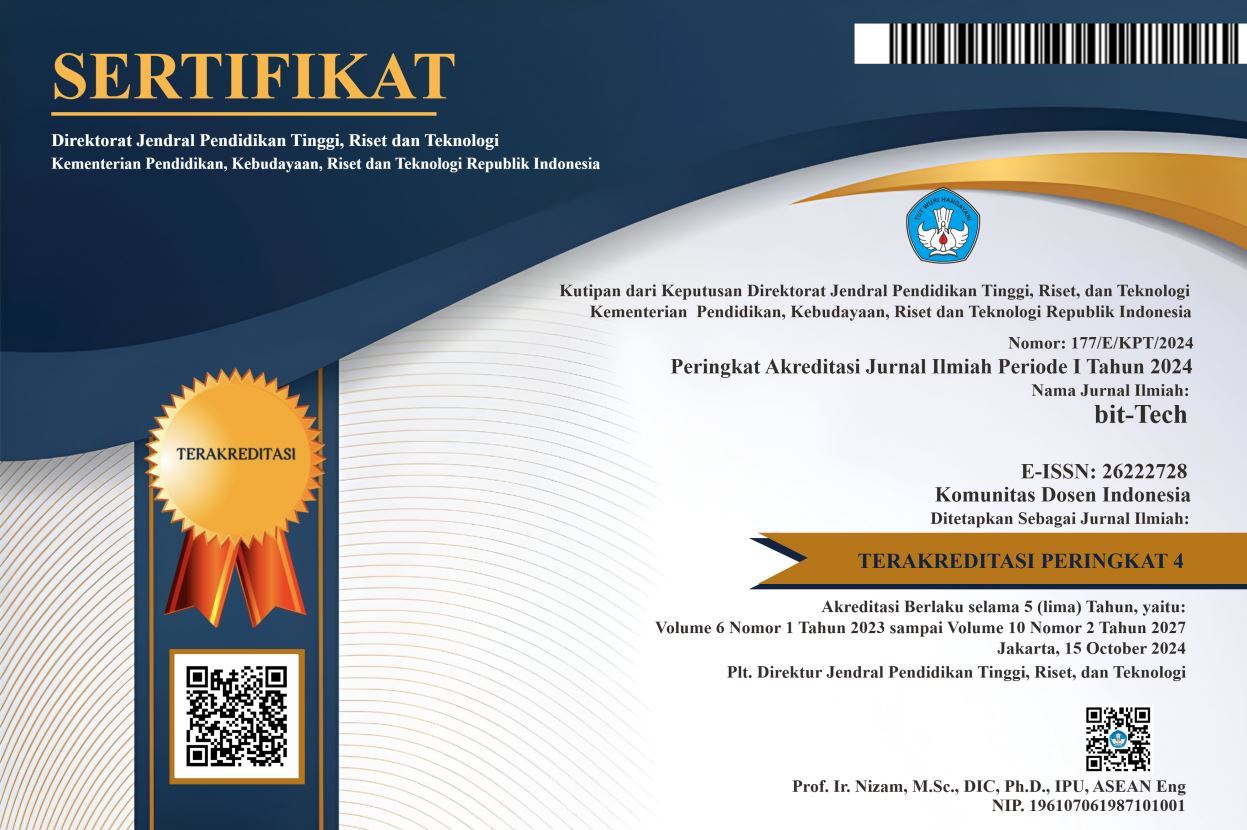Flood Monitoring Early Warning System using Internet of Things-based Telegram
DOI:
https://doi.org/10.32877/bt.v6i3.971
Keywords:
Early Warning System, Monitoring, Fuzzy Logic, Telegram, Internet Of Things (IOT)
Abstract
Technology can be considered a human invention that is used to facilitate human activities. In the current increase and growth of technology, there are many technologies that have been created from time to time. Flooding is a natural disaster that can be caused by human behavior itself. Many floods occur due to blockage of water flow in gutters or drainage systems. The impact of a flood disaster are many things that harm us, if a flood occurs, it doesn't just result in material loss, it can even cause loss of life. Therefore, this research aims to create an Early Warning System for handling flood disasters based on the Internet of Things (IOT) using telegram as a monitoring control. According to the rule, if the water level distance is less than 10 cm, then the water level will be declared safe from flooding. Then, if it is greater than 10 cm and less than 15 cm, a flood warning will be issued, and if the water level is more than 15 cm, there will be a danger of flooding. The results of this research will show that this tool can detect water levels and send a warning/notification from the Telegram application.
Downloads
References
Y. Efendi, “Internet Of Things (IOT) Sistem Pengendalian Lampu Menggunakan Raspberry PI Berbasis Mobile,” Jurnal Ilmiah Ilmu Komputer, vol. 4, no. 1, pp. 19–26, 2018, [Online]. Available: http://ejournal.fikom-unasman.ac.id
M. Usnaini, V. Yasin, and A. Z. Sianipar, “Perancangan sistem informasi inventarisasi aset berbasis web menggunakan metode waterfall,” Jurnal Manajamen Informatika Jayakarta, vol. 1, no. 1, p. 36, Feb. 2021, doi: 10.52362/jmijayakarta.v1i1.415.
Sarmid and R. Sidik Ibnu, “Sistem Peringatan Dini Banjir Menggunakan Sensor Ultrasonik Berbasis Arduino Uno,” Jurnal Manajemen Dan Teknik Informatika, vol. 03, pp. 31–41, 2019.
S. Peringatan Dini Banjir, Z. Zainuddin, A. Latif Arda, and A. Zulkifli Nusri, “SISTEM PERINGATAN DINI BANJIR,” Jurnal Teknologi Informasi dan Komunikasi, vol. 9, no. 2, pp. 167–173, 2019.
S. Suwardi, “Mitigasi Bencana Banjir dengan Sistem Informasi Monitoring,” 2019, doi: 10.14710/teknik.v40n1.23342.
R. Aditya, V. Handrianus Pranatawijaya, P. Bagus Adidyana Anugrah Putra, J. Hendrik Timang, K. Palangkaraya, and K. Tengah, “Rancang Bangun Aplikasi Monitoring Kegiatan Menggunakan Metode Prototype,” 2021.
F. Fitriansyah, “Penggunaan Telegram Sebagai Media Komunikasi Dalam Pembelajaran Online,” vol. 20, no. 2, 2020, doi: 10.31294/jc.v20i2.
A. D. Mulyanto, “Pemanfaatan Bot Telegram Untuk Media Informasi Penelitian,” MATICS, vol. 12, no. 1, p. 49, Apr. 2020, doi: 10.18860/mat.v12i1.8847.
B. Pasaribu and W. Susanti, “Sistem Informasi Pengajuan Rancangan Usulan Penelitian Menggunakan PHP Native dan Bot Telegram,” Jurnal Mahasiswa Aplikasi Teknologi Komputer dan Informasi, vol. 3, no. 1, 2021, [Online]. Available: http://www.php.net.
A. Fathurrozi and F. Karimah, “Pelayanan Dan Informasi Customer Service Berbasis Bot Telegram DenganAlgoritma Forward Chaining Pada CV.Primguard Indonesia,” Journal of Information and Information Security (JIFORTY), vol. 2, no. 2, pp. 211–226, 2021, [Online]. Available: http://ejurnal.ubharajaya.ac.id/index.php/jiforty
Murtopo, Khairil, and Gunawan, “Perancangan Media Pembelajaran Agama Islam Secara Interaktif Berbasis Aplikasi Telegram Bot pada Politeknik Negeri Media Kreatif,” ANALYTICA ISLAMICA, vol. 11, no. 2, 2022, [Online]. Available: https://balitbangsdm.kominfo.go.id
A. I. Yusuf, S. Samsugi, and F. Trisnawati, “SISTEM PENGAMAN PINTU OTOMATIS DENGAN MIKROKONTROLER ARDUINO DAN MODULE RF REMOTE,” 2020. [Online]. Available: http://jim.teknokrat.ac.id/index.php/teknikelektro/index
M. Susilo and R. Kurniati, “RANCANG BANGUN WEBSITE TOKO ONLINE MENGGUNAKAN METODE WATERFALL,” 2018.
A. A. Wahid, “Jurnal Ilmu-ilmu Informatika dan Manajemen STMIK Oktober (2020) Analisis Metode Waterfall Untuk Pengembangan Sistem Informasi,” Jurnal Ilmu-ilmu Informatika dan Manajemen STMIK, 2020.
N. Hidayati, “Penggunaan Metode Waterfall Dalam Rancang Bangun Sistem Informasi Penjualan,” 2019.
Downloads
Published
How to Cite
Issue
Section
License
Copyright (c) 2024 bit-Tech : Binary Digital - Technology

This work is licensed under a Creative Commons Attribution-ShareAlike 4.0 International License.
I hereby assign and transfer to bit-Tech all exclusive copyright ownership rights to the above work. This includes, but is not limited to, the right to publish, republish, downgrade, distribute, transmit, sell, or use the work and other related materials worldwide, in whole, or in part, in all languages, in electronic, printed, or any other form of media, now known or hereafter developed and reserves the right to permit or license a third party to do any of the above. I understand that this exclusive right will belong to bit-Tech from the date the article is accepted for publication. I also understand that bit-Tech, as the copyright owner, has sole authority to license and permit reproduction of the article. I understand that, except for copyright, any other proprietary rights associated with the work (e.g. patents or other rights to any process or procedure) must be retained by the author. In addition, I understand that bit-Tech permits authors to use their papers in any way permitted by the applied Creative Commons license.


 DOI :
DOI :
 Abstract views: 196
/
Abstract views: 196
/  PDF downloads: 203
PDF downloads: 203











